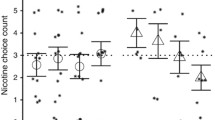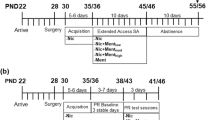Abstract
Rationale
Reducing nicotine content of inhaled tobacco products may prevent nicotine addiction, but the threshold for nicotine reinforcement has not been systematically evaluated in controlled human laboratory studies.
Objectives
The current study uses a novel double-blind placebo-controlled intravenous (IV) nicotine self-administration (NSA) model to determine threshold for subjective effects of nicotine and nicotine reinforcement using a forced choice self-administration procedure.
Methods
Young adults (n = 34) had 5 laboratory sessions after overnight nicotine abstinence. In each session, participants sampled and rated the subjective effects of an IV dose of nicotine (0.0125, 0.025, 0.05, 0.1, or 0.2 mg nicotine/70 kg bodyweight) versus saline (placebo), then were given a total of 10 opportunities to self-administer either the IV dose of nicotine or placebo.
Results
Mixed effect models revealed a significant effect of nicotine dose for positive (i.e., “stimulatory” and “pleasurable”; p < .0001) effects, but not “aversive” effects during sampling period. Post hoc comparisons showed that higher doses (i.e., 0.1 and 0.2 mg) were associated with greater stimulatory, pleasurable, and physiological effects than placebo and lower doses. Mixed effect models revealed that only the highest dose (i.e., 0.2 mg) was consistently preferred over placebo. Sex differences were generally weak (p = .03–.05).
Conclusions
Using our IV nicotine NSA model, the threshold for detecting positive effects of nicotine in young adult smokers is about 0.1 mg, but a higher dose of nicotine, 0.2 mg, is required to produce a consistent nicotine reinforcement. Regarding the regulatory impact, our findings further support the value of nicotine reinforcement threshold as a tobacco regulatory target.



Similar content being viewed by others
References
Alexander LA, Trinidad DR, Sakuma KL, Pokhrel P, Herzog TA, Clanton MS et al (2016) Why we must continue to investigate menthol's role in the African American Smoking Paradox. Nicotine Tob Res 18(Suppl 1):S91–S101. https://doi.org/10.1093/ntr/ntv209
American Psychiatric Association (2013) Diagnostic and statistical manual of mental disorders (DSM-5®): American Psychiatric Pub
Benowitz NL, Henningfield JE (1994) Establishing a nicotine threshold for addiction. The implications for tobacco regulation. N Engl J Med 331(2):123–125
Benowitz NL, Henningfield JE (2013) Reducing the nicotine content to make cigarettes less addictive. Tob Control 22(Suppl 1):i14–i17. https://doi.org/10.1136/tobaccocontrol-2012-050860
Benowitz NL, Herrera B, Jacob P 3rd. (2004) Mentholated cigarette smoking inhibits nicotine metabolism. J Pharmacol Exp Ther 310(3):1208–1215. https://doi.org/10.1124/jpet.104.066902
Cassidy RN, Miller ME, Tidey JW, DiGuiseppi G, Denlinger-Apte R, Colby SM (2019) The impact of nicotine dose on the reinforcing value of cigarettes in adolescents. Tob Regul Sci 5(2):105–114
Cohen J (1992) A power primer. Psychol Bull 112(1):155–159
DeVito EE, Herman AI, Waters AJ, Valentine GW, Sofuoglu M (2014) Subjective, physiological, and cognitive responses to intravenous nicotine: effects of sex and menstrual cycle phase. Neuropsychopharmacology 39(6):1431–1440. https://doi.org/10.1038/npp.2013.339
Djordjevic MV, Stellman SD, Zang E (2000) Doses of nicotine and lung carcinogens delivered to cigarette smokers. J Natl Cancer Inst 92(2):106–111
Donny EC, Denlinger RL, Tidey JW, Koopmeiners JS, Benowitz NL, Vandrey RG, al’Absi M, Carmella SG, Cinciripini PM, Dermody SS, Drobes DJ, Hecht SS, Jensen J, Lane T, le CT, McClernon FJ, Montoya ID, Murphy SE, Robinson JD, Stitzer ML, Strasser AA, Tindle H, Hatsukami DK (2015) Randomized trial of reduced-nicotine standards for cigarettes. N Engl J Med 373(14):1340–1349. https://doi.org/10.1056/NEJMsa1502403
Hatsukami, D. K., Luo, X., Jensen, J. A., al’Absi, M., Allen, S. S., Carmella, S. G., . . . Drobes, D. J. (2018). Effect of immediate vs gradual reduction in nicotine content of cigarettes on biomarkers of smoke exposure: a randomized clinical trial. Jama, 320(9), 880-891.
Jensen KP, DeVito EE, Herman AI, Valentine GW, Gelernter J, Sofuoglu M (2015a) A CHRNA5 smoking risk variant decreases the aversive effects of nicotine in humans. Neuropsychopharmacology 40(12):2813–2821. https://doi.org/10.1038/npp.2015.131
Jensen KP, Herman AI, Morean ME, Kranzler HR, Gelernter J, Sofuoglu M (2015b) FKBP5 variation is associated with the acute and chronic effects of nicotine. Pharm J 15(4):340–346. https://doi.org/10.1038/tpj.2014.76
Jensen KP, DeVito EE, Sofuoglu M (2016a) How intravenous nicotine administration in smokers can inform tobacco regulatory science. Tob Regul Sci 2(4):452–463
Jensen KP, DeVito EE, Valentine G, Gueorguieva R, Sofuoglu M (2016b) Intravenous nicotine self-administration in smokers: dose–response function and sex differences. Neuropsychopharmacology 41(8):2034–2040
Krebs, N. M., Zhu, J., Wasserman, E., Kuprewicz, R., Martinez, D. J., Veldheer, S., Livelsberger C., Modesto J., Reinhart L., Trushin N., Reilly S. M., Liao J., Fazzi A., Bascom R., Richie Jr J. P., Foulds J., Horn K. Muscat, J. E. (2020). Switching to progressively reduced nicotine content cigarettes in smokers with low socioeconomic status: a double-blind randomized clinical trial. Nicotine Tob Res https://doi.org/10.1093/ntr/ntaa247
Morean ME, de Wit H, King AC, Sofuoglu M, Rueger SY, O'Malley SS (2013) The drug effects questionnaire: psychometric support across three drug types. Psychopharmacology 227(1):177–192. https://doi.org/10.1007/s00213-012-2954-z
Perkins KA (2008) Sex differences in nicotine reinforcement and reward: influences on the persistence of tobacco smoking. The motivational impact of nicotine and its role in tobacco use:143–169
Perkins KA (2019) Research on behavioral discrimination of nicotine may inform FDA policy on setting a maximum nicotine content in cigarettes. Nicotine Tob Res 21(Suppl 1):S5–S12. https://doi.org/10.1093/ntr/ntz136
Perkins KA, Kunkle N, Karelitz JL (2017a) Preliminary test of cigarette nicotine discrimination threshold in non-dependent versus dependent smokers. Drug Alcohol Depend 175:36–41. https://doi.org/10.1016/j.drugalcdep.2017.01.033
Perkins KA, Kunkle N, Karelitz JL, Perkins KA, Kunkle N, Karelitz JL (2017b) Preliminary test of cigarette nicotine discrimination threshold in non-dependent versus dependent smokers. Drug Alcohol Depend 175:36–41. https://doi.org/10.1016/j.drugalcdep.2017.01.033
Sofuoglu M, LeSage MG (2012) The reinforcement threshold for nicotine as a target for tobacco control. Drug Alcohol Depend 125(1-2):1–7
Sofuoglu M, Yoo S, Hill KP, Mooney M (2008) Self-administration of intravenous nicotine in male and female cigarette smokers. Neuropsychopharmacology 33(4):715–720
Sofuoglu M, Herman AI, Nadim H, Jatlow P (2012) Rapid nicotine clearance is associated with greater reward and heart rate increases from intravenous nicotine. Neuropsychopharmacology 37(6):1509–1516. https://doi.org/10.1038/npp.2011.336
Valentine GW, DeVito EE, Jatlow PI, Gueorguieva R, Sofuoglu M (2018) Acute effects of inhaled menthol on the rewarding effects of intravenous nicotine in smokers. J Psychopharmacol 32(9):986–994
Acknowledgements
The authors thank Ms. Haleh Nadim for measurements of nicotine and cotinine.
Funding
This work was funded by a US Department of Veteran Affairs Career Development Award, Mental Illness Research Education Clinical, Centers (MIRECC), and NIDA/NIH and FDA Center for Tobacco Products (CTP) R01 DA042528 (MS). The content is solely the responsibility of the authors and does not necessarily represent the official views of the National Institutes of Health or the FDA.
Author information
Authors and Affiliations
Corresponding author
Ethics declarations
Conflict of interest
The authors declare no competing interests.
Additional information
Publisher’s note
Springer Nature remains neutral with regard to jurisdictional claims in published maps and institutional affiliations.
Rights and permissions
About this article
Cite this article
MacLean, R.R., DeVito, E.E., Eid, T. et al. Threshold dose for intravenous nicotine self-administration in young adult non-dependent smokers. Psychopharmacology 238, 2083–2090 (2021). https://doi.org/10.1007/s00213-021-05833-8
Received:
Accepted:
Published:
Issue Date:
DOI: https://doi.org/10.1007/s00213-021-05833-8




